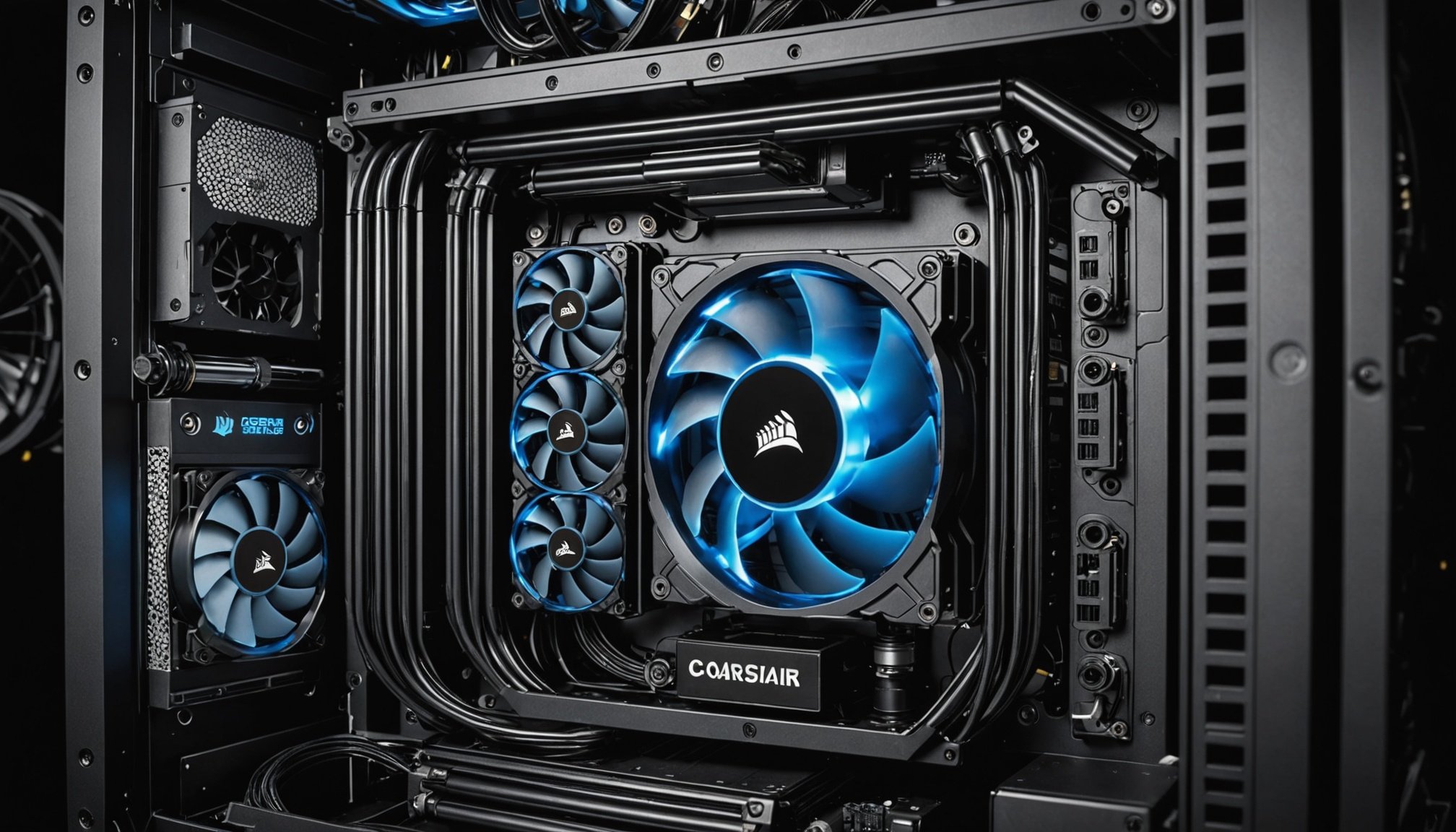Understanding the Corsair Crystal Series 680X Case
The Corsair Crystal 680X is a standout in the world of PC cases, known for its unique design and robust functionality. It is particularly favoured for its spacious interior, making it ideal for building powerful setups, including dual GPU setups. With its dual-chamber layout, the case is meticulously designed to separate key components, significantly contributing to enhanced airflow optimization.
Airflow Optimization and Dual GPUs
One of the primary benefits of the Corsair Crystal 680X is its ability to tackle airflow challenges head-on. In dual GPU configurations, effective cooling becomes indispensable to prevent overheating. This case accommodates multiple fans and radiators, promoting superior cooling efficiency. Such optimized airflow is crucial to ensure that the powerful components within the case run smoothly without throttling.
Also to read : Ultimate guide to configuring your pcie capture card for exceptional live streaming on custom pcs with obs studio
Challenges in Maintaining Optimal Cooling
Maintaining optimal cooling in dual GPU setups can pose significant challenges. Users often struggle with ensuring consistent airflow and dealing with heat buildup. The innovative design of the Corsair Crystal 680X addresses these issues by allowing for meticulous airflow optimization, ensuring components operate within safe temperature ranges. Additionally, the exquisite tempered glass panels not only provide visual appeal but also allow for easy monitoring of the internal setup.
Essential Components for Optimal Airflow
Creating an efficient cooling solution involves carefully balancing cooling components, such as case fans and radiators. Let’s delve into the essentials of selecting and placing these components for maximum airflow.
Also to discover : The definitive playbook for crafting a high-octane gaming rig: featuring intel core i7-11700k and nvidia rtx 3070 in the eye-catching lian li pc-o11 dynamic case
Selecting the Right Case Fans
When selecting case fans, understanding the difference between static pressure and airflow fans can greatly impact your setup’s efficiency. Static pressure fans are ideal for pushing air through tight spaces like optical or hard drive bays and radiators. In contrast, airflow fans work best in open areas, efficiently moving air through your case. Matching the correct fan to the right application ensures optimal performance.
Choosing Efficient Radiators
Radiators are integral to liquid cooling systems. The size typically dictates the heat dissipation capability; larger radiators disperse more heat but require space. When choosing a radiator, consider your system’s thermal demands and adjust the number or size accordingly. Expandability and support for multiple radiator setups can future-proof your cooling solution.
Placement for Maximum Airflow
Effective airflow is achieved through strategic placement of cooling components. Top-mounted radiators should exhaust hot air, while bottom-mounted ones can draw cool air. Balance intake and exhaust fans to create a smooth airflow stream, reducing hotspots. Aided by a thoughtful layout, your cooling system will perform efficiently without excessive noise or heat buildup.
Case Modifications for Enhanced Airflow
Optimising case modifications plays a crucial role in improving airflow within your PC system, ensuring effective thermal management. One important strategy is modifying drive bays, which involves strategically removing or rearranging them to create a clearer path for airflow. This adjustment can significantly enhance the air circulation towards key components, such as the CPU and GPU, preventing overheating and improving overall system stability.
Utilising dust filters is another critical aspect of maintaining cleanliness and ensuring long-term airflow efficiency. Dust accumulation can obstruct airflow paths and clog fans, reducing cooling effectiveness. Incorporating high-quality dust filters at entry points helps prevent particulates from entering the case, preserving both airflow and component longevity.
Effective cable management techniques also contribute greatly to a system’s airflow. Properly organising cables, either by tucking them behind the motherboard tray or using zip ties, ensures they don’t block airflow paths within the case. Clear air channels allow for better circulation of cool air, thus enhancing the cooling system’s performance.
By focusing on airflow improvements through these modifications, users can not only increase their PC’s performance but also reduce noise levels from fans working excessively. Implementing these techniques ensures a more efficient, quieter, and longer-lasting PC experience.
Setting Up Your Dual GPU Configuration
Setting up a dual GPU configuration can significantly boost gaming and computational power when approached correctly.
Recommended GPU Placement Strategies
Proper GPU placement is crucial. Ideally, position your GPUs in slots with adequate spacing to maximise airflow, ensuring each one gets fresh air for cooling. If space is limited, consider using riser cables for better thermal performance.
Managing Heat Generation
Heat is an inevitable by-product of dual GPUs. To manage this, implement cooling solutions such as high-performance fans or liquid cooling systems. Applying high-quality thermal pads can also aid in heat dissipation by improving thermal transfer between components. Regular cleaning to remove dust accumulation further enhances thermal efficiency.
Crossfire vs SLI Configuration Considerations
Choosing between Crossfire and SLI configurations mandates knowing the technicalities of each. Both systems require compatible graphics cards and motherboards. Crossfire generally offers more flexibility in GPU combinations, while SLI has stricter compatibility requirements but often provides better thermal performance due to its proprietary technology. Monitoring software applications can help track temperatures and performance, adjusting your setup as necessary to prevent overheating.
Performance Benchmarks and Comparisons
Achieving optimal performance benchmarks requires a keen understanding of how various factors contribute to thermal management. One critical element is fan configuration. A well-thought-out configuration significantly affects cooling efficiency, especially when handling dual GPU cooling scenarios. In testing, configurations utilizing a balanced flow improved temperature control, sustaining ideal thermal benchmarks without sacrificing acoustics.
Equally important are case modifications—these typically involve strategic placement adjustments or additional ducting to enhance airflow. Such modifications have been shown to bolster cooling systems, offering marked improvements in thermal benchmarks without requiring extensive overhauls or new hardware investments.
When examining the Corsair 680X, it’s evident that various cooling products yield distinct results. For instance, liquid cooling solutions consistently lower temperatures more effectively than standard air coolers, aligning with expectations for dual GPU cooling. Performance metrics highlight certain cooling products surpass others in maintaining operational stability under load.
These insights emphasize the necessity of informed choice in cooling solutions, underlining how a comprehensive understanding can lead to superior performance benchmarks. This ensures not only optimal functioning of hardware components but also longevity and reliability in high-demand scenarios.
Advanced Cooling Solutions
Navigating the world of computer cooling systems requires understanding a few key elements. Advanced cooling solutions can significantly enhance PC performance, particularly when dealing with high-performance systems.
Utilizing Liquid Cooling Systems
Liquid cooling is an effective means of reducing heat in dual GPU setups. Unlike air cooling, liquid cooling efficiently transfers heat away from components using a liquid-filled loop. The benefit of this method lies in its ability to maintain lower temperatures, favoring extended gaming or intensive computational tasks. Aside from the hardware setup, users should consistently check and maintain these systems for any leaks or component wear.
Customizing Fan Curves for Optimal Performance
Designing custom fan curves allows users to manage their PC’s cooling and noise levels efficiently. By adjusting these curves via software, you ensure that fans operate at desirable speeds based on the system’s temperature. Enhanced control lets users balance between optimal cooling and audible noise, providing a tailored experience across various tasks.
Implementing Additional Cooling Accessories
For those looking to maximize cooling, additional accessories can make a significant difference. Items such as GPU backplates and VRM cooling solutions contribute to an even heat distribution across components. Furthermore, innovative accessories ensure that sensitive parts like voltage regulators maintain a cooler, stable environment – crucial for maintaining the lifespan of your components.
Final Optimization Tips
Achieving performance optimization involves several key practices to maintain and enhance your PC’s capabilities. Firstly, it is important to regularly clean and dust your system to ensure cooling efficiency. This helps avoid overheating and maintains the longevity of your components. Pay attention to case airflow by carefully managing your cables and placing your hardware strategically for optimal heat dissipation.
Monitoring in-game temperatures is crucial for real-time performance adjustments. Utilize software tools to track your system’s heat levels while gaming. If you notice high temperatures, consider upgrading your cooling system or adjusting fan speeds to improve efficiency and protection against possible damage.
For those uncertainties you might face, community resources and forums are invaluable. Numerous online platforms are available where fellow enthusiasts discuss troubleshooting techniques and share experiences about hardware optimization. These communities can be a great source of optimization advice, especially when striving for peak performance.
Ensuring your equipment functions efficiently involves a mixture of regular maintenance, careful monitoring, and active engagement with user communities. Such steps will not only enhance case airflow but also help achieve higher performance levels, enabling a smoother and more enjoyable gaming experience.











